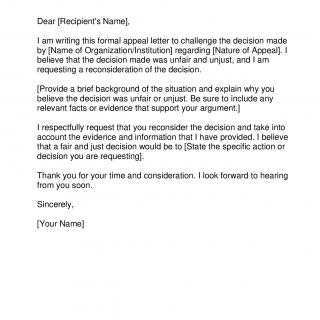Formal Appeal Letter
A Professional and Structured Approach to Address Appeals
A formal appeal letter is a written document used to address various types of appeals in a professional and structured manner. It is a formal way of presenting a clear and concise argument to the intended recipient. This type of letter adheres to formal language and formatting conventions, making it an effective tool in legal proceedings, academic disputes, insurance claims, or any situation that requires a formal appeal process.
The main purpose of a formal appeal letter is to present a clear and concise argument to the intended recipient. It is used to address various types of appeals in a professional and structured manner.
A formal appeal letter consists of several parts, including the introduction, the body, and the conclusion. The introduction should state the purpose of the letter, while the body should present the argument in a clear and concise manner. The conclusion should summarize the main points and request a specific action or decision.
When writing a formal appeal letter, it is important to consider the intended recipient, the nature of the appeal, and any relevant laws or regulations. It is also important to provide any supporting evidence or documentation that may strengthen the argument.
The parties involved in a formal appeal letter may vary depending on the nature of the appeal. It may involve individuals, organizations, or government agencies.
When writing a formal appeal letter, it is important to provide any relevant data or documentation that supports the argument. This may include legal documents, academic transcripts, or medical records.
Formal appeal letters can be used in a variety of situations, including academic disputes, insurance claims, and legal proceedings. For example, a student may write a formal appeal letter to challenge a grade, while an individual may write a formal appeal letter to challenge a denial of insurance coverage.
Sample of Formal Appeal Letter
Dear [Recipient's Name],
I am writing this formal appeal letter to challenge the decision made by [Name of Organization/Institution] regarding [Nature of Appeal]. I believe that the decision made was unfair and unjust, and I am requesting a reconsideration of the decision.
[Provide a brief background of the situation and explain why you believe the decision was unfair or unjust. Be sure to include any relevant facts or evidence that support your argument.]
I respectfully request that you reconsider the decision and take into account the evidence and information that I have provided. I believe that a fair and just decision would be to [State the specific action or decision you are requesting].
Thank you for your time and consideration. I look forward to hearing from you soon.
Sincerely,
[Your Name]
The strengths of a formal appeal letter include its formal language and structured approach, which can make it an effective tool in addressing appeals. However, its weaknesses may include its reliance on legal or regulatory frameworks, which may limit its effectiveness in certain situations. Opportunities for using a formal appeal letter may include the ability to challenge decisions or actions that may be unfair or unjust. Threats may include the potential for the appeal to be denied or dismissed.
Related forms may include informal appeal letters or petitions, while alternative forms may include mediation or arbitration. The main difference between a formal appeal letter and these alternative forms is the level of formality and structure.
The future implications of a formal appeal letter may vary depending on the outcome of the appeal. If the appeal is successful, it may result in a change in decision or action. If the appeal is unsuccessful, it may result in the need for further legal action or alternative forms of dispute resolution.
Formal appeal letters are typically submitted to the intended recipient through mail or email. It is important to keep a copy of the letter for personal records. If the appeal is part of a legal proceeding, it may be stored as part of the official court record.

